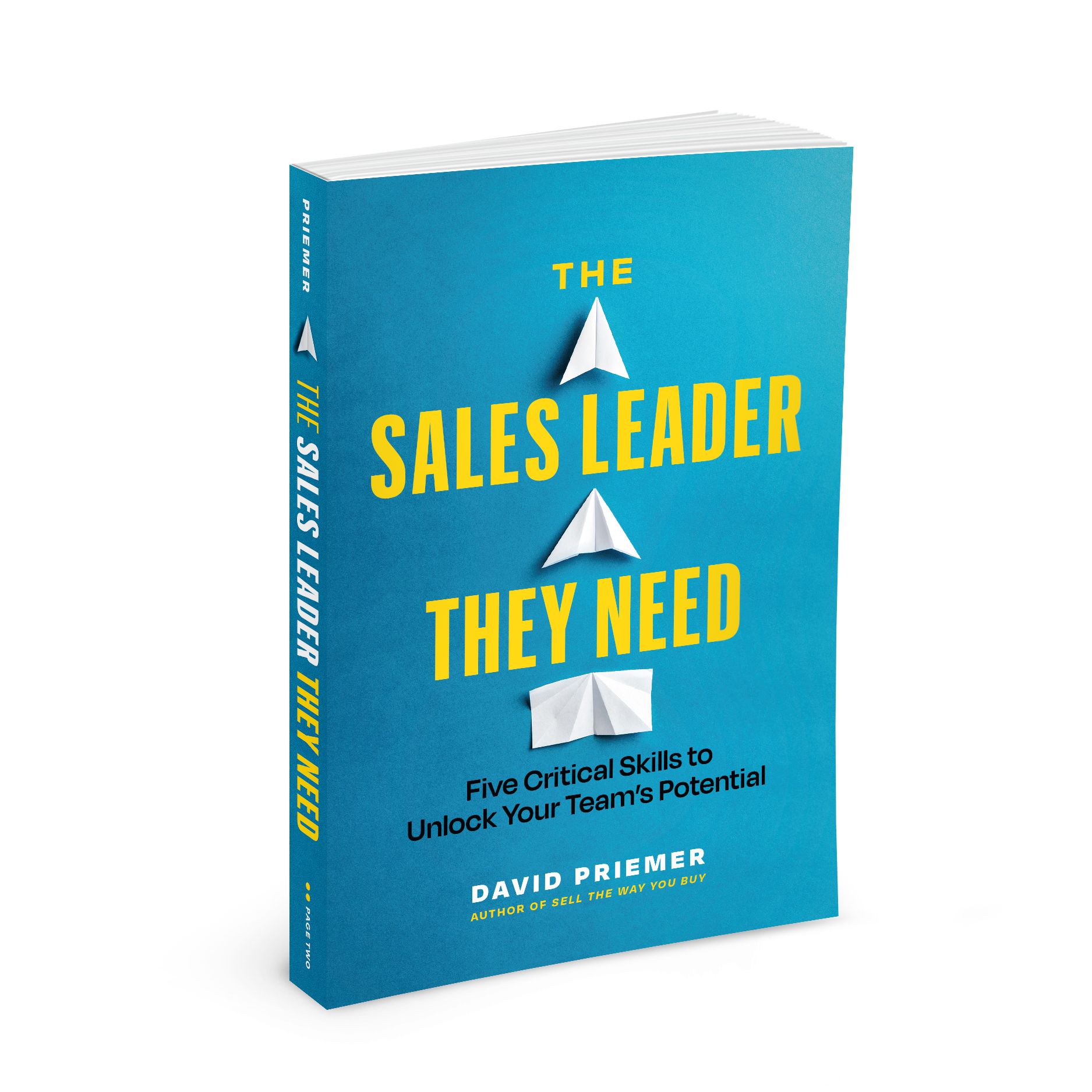5 Tips for Building a Sales Culture Optimized for Growth
When I was a VP at Salesforce, one of my sales managers came to me with a disturbing problem. He told me he got a voicemail from a customer saying that he didn’t want to work with the female sales rep responsible for his account and requested that we assign a man to help him. “What do you think we should do, David?”, he asked.
No matter how detailed your onboarding manual or how comprehensive your ongoing professional development is, sooner or later each of your team members and colleagues will encounter a situation just like this. One that no amount of formal training can prepare them for.
In the interest of making this a teachable moment, I raised an eyebrow and replied, “Well, what do you think we should do?”
I could see his internal conflict. On one hand, he really wanted to call the customer back and tell him off! On the other, we dealt with problematic customers like this all the time (albeit never with this type of request). Maybe, in this case, he felt it would cause less friction to apologize profusely to the female rep for the customer’s inappropriate request, but ultimately comply in the name of avoiding a confrontation.
Making these types of decisions strikes to the very core of your corporate culture. And if you want to build an organization optimized for rapid growth, that culture needs to be visible, repeatable, and pervasive.
(more on how this situation played out later in the post!)
Culture Eats Adversity for Breakfast
The role of culture is especially critical as leaders try to navigate adverse and uncertain times like those we’ve experienced in the past few years.
Bill Aulet is the managing director of the Martin Trust Center for MIT Entrepreneurship and a senior lecturer at the MIT Sloan School of Management. In an article for TechCrunch he talked about the importance of culture with respect to growth stating:
“I used to think corporate culture didn’t matter. Discussion of vision, mission and values was for people who couldn’t build a product or sell it! We had work to do and this MBA BS was getting in the way! And then my first company failed…because we had no meaningful purpose to create team unity to fight through the tough times.”
In his bestselling book, Leaders Eat Last, author Simon Sinek reinforces the importance of culture when it comes to overcoming adversity. He states:
“The strength of the culture, and not the size of its resources, determine an organization’s ability to adapt to the times, overcome adversity, and pioneer new innovations. When a strong Circle of Safety is present and felt by all, we do what we do best. We act in the manner for which we are designed. We pull together.”
If you’re a sales leader looking to help your company grow by investing in the power of culture, here are five critical tips:
1. Be Mindful That YOU Set The Tone
My friend Molly Graham knows a thing or two about culture. An early employee at Facebook, she was also the COO of Quip which was acquired by Salesforce in 2016 for $750 million. There she worked closely with CEO Bret Taylor, who went on to become, until recently, co-CEO of the $150B giant.
In a post in FirstRound capital, she states that 80% of company culture is defined by organizational leaders. It shares a story from the early days of Facebook where CEO Mark Zuckerberg used the “one of us” to help codify their culture. As part of this exercise, Zuckerberg wrote a list of characteristics he felt described what it meant to be a member of the Facebook team. It included qualities like, a very high IQ, a strong sense of purpose, a relentless focus on success, and enjoys changing and disrupting things.
While these descriptors went on to build the foundation of the company culture rewrite, it’s clear that many of them reflect the personality of Zuckerberg himself.
Like it or not, as a leader you need to be extremely mindful that you set the tone for your team. What you believe, how you conduct yourself, and the behavior you tolerate will be directly reflected by your crew.
2. Get Your Values Straight & Make Them Visible
To successfully build an organizational culture that breeds a resilient team, you need to have a clear understanding of what your company stands for.
Whether you decide to use a top-down approach to defining your values or prefer to go bottom-up and crowdsource them through a communal exercise, the key part here is simply doing it. Without clear-cut organizational beliefs, your team has nothing to ground themselves as they navigate the often uncertain corporate world.
With that in mind, it’s not enough to have values, they need to be crystalized, written down, and made visible. Paint them on the walls. Add them to every meeting agenda. Integrate them into the hiring process by showcasing them to your candidates, and consistently revisit them during training exercises.
In my last VP role, I wanted to instill the values of knowledge, leadership, and reciprocity in my team. They appeared on the intro slide at every team meeting, team members were periodically quizzed as to their meaning, and we even had them printed on the back of the T-shirts we gave out at our kickoff meetings.
If you want your culture to flourish, make it impossible for your team to forget what it is you all stand for!
3. Be Consistent & Recognize Winning Behaviors
Multi-million dollar companies are not monoliths. Many have crashed and burned despite company values being defined and documented.
For example, there was once a company that shared values strikingly similar to the United States Air Force. In fact, their four values were chiseled in marble in the main lobby of their corporate headquarters.
Integrity, Communication, Respect. Excellence.
Then in the Fall of 2001, the now-famous collapse of Enron was complete. An article documenting their downfall states that “Enron’s leadership fooled regulators with fake holdings and off-the-books accounting practices.” Practices hardly consistent with their stated values.
That’s why if you want to build a culture where winning behaviors aligned with your values are recognized and most importantly, replicated, you need to memorialize them and make them visible when you see them happening…consistently.
First, start by deciding which winning behaviors align with your values. For example, do you value innovation? Learning? Teamwork? Fanatical customer service?
Next, make sure you and your team have a mechanism to call these behaviors out and make them visible when they happen. For example, call them out on an internal social network like Slack (even with a dedicated channel) or at regular company or team meetings to drive the positive reinforcement you’re after. But remember, superlatives like “Great job!” or “Amazing work!” aren’t helpful. Be specific! Call out the specific behaviors and the outcome they drove. The more specific you can be about the behavior and its value in your business, the easier it will be for others to replicate it.
4. Hire (and Fire) for Culture.
Infusing company culture into your hiring process is not only a great way to attract like-minded talent with long-term compatibility, but it’s also a key way to identify and weed out toxic elements. In other words, hiring for culture not only improves performance and also reduces downside.
Some of the best organizations and leaders have stories of letting even their top-performing team members go because of the detrimental effect they were having on the culture.
A Harvard Business School study of 60,000+ employees found that keeping toxic workers within the workplace significantly decreases the productivity and profitability of entire teams with:
- 80% of employees reporting lost work time due to worry of offending the toxic employee’s rudeness
- 66% of employees reporting decreased performance
- 38% of employees reporting an intentional decrease in their quality of work
- 12% of employees leaving their jobs due to uncivil treatment.
Additionally, researchers found that one top performer who works in line with company values drives more than $5,300 in cost savings, whereas, avoiding a toxic hire or firing a toxic employee drives $12,500 in cost savings.
This means leaders would be well-served to bake not only skill but culture-centric evaluation criteria into their recruiting process. For example, if empathy and emotional intelligence are part of your core values, consider asking candidates interview questions that help assess their degree of alignment (here are some of my favorites).
5. Be Predictable.
Culture is what people do when no one is looking.
It’s important to not only be consistent in how you live and propagate your culture but also how predictable you are as a leader. The truth is, as your team and organization grow, it’s impossible for you to be involved in every conversation or decision. Your goal as a leader should be to make your advice and perspective so predictable that your team members and colleagues can anticipate and count on them, even in your absence.
In the case of my manager who was struggling with how to respond to the off-side customer request, I decided to rephrase the question.
“What would our CEO, Marc Benioff, do if he were in your shoes right now?”
The answer became immediately clear.
Equality and trust (between our customers and employees) were two of our core values that been deeply engrained into our culture. So without hesitation, the manager called the customer back and said, “While we respect your right to have an opinion, if you won’t work with a woman then Salesforce is probably not the company you want to be doing business with.”
Culture is not only a secret weapon but an integral and critical part of building an organization and team optimized for growth. But it doesn’t happen on its own. It requires consistent effort, mindful execution, and like the most beautiful gardens, careful cultivation. By implementing the right practices and practicing them early and often, both the bottom line and existential payoffs can be extraordinary.
We promise never to send you junk or share your email! Just helpful sales insights.













